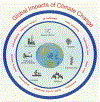Mechanisms of climate change and related air pollution on the immune system leading to allergic disease and asthma
- PMID: 37105834
- PMCID: PMC10275624
- DOI: 10.1016/j.smim.2023.101765
Mechanisms of climate change and related air pollution on the immune system leading to allergic disease and asthma
Abstract
Climate change is considered the greatest threat to global health. Greenhouse gases as well as global surface temperatures have increased causing more frequent and intense heat and cold waves, wildfires, floods, drought, altered rainfall patterns, hurricanes, thunderstorms, air pollution, and windstorms. These extreme weather events have direct and indirect effects on the immune system, leading to allergic disease due to exposure to pollen, molds, and other environmental pollutants. In this review, we will focus on immune mechanisms associated with allergy and asthma-related health risks induced by climate change events. We will review current understanding of the molecular and cellular mechanisms by which the changing environment mediates these effects.
Keywords: Allergy; Asthma; Climate change; Pollen; Pollution; Wildfire.
Copyright © 2023 Elsevier Ltd. All rights reserved.
Conflict of interest statement
Declaration of Competing Interest The authors declare that they have no relevant conflicts of interest.
Figures





References
-
- Earth Observatory, World of Change: Global Temperatures, 2022. https://earthobservatory.nasa.gov/world-of-change/global-temperatures. (Accessed December 6 2022).
-
- National Oceanic and Atmospheric Administration, Carbon dioxide now more than 50% higher than pre-industrial levels, 2020. https://www.noaa.gov/news-release/carbon-dioxide-now-more-than-50-higher.... (Accessed December 6 2022).
-
- National Oceanic and Atmospheric Administration, Ocean acidification, 2022. https://www.noaa.gov/education/resource-collections/ocean-coasts/ocean-a.... (Accessed December 12 2022).

